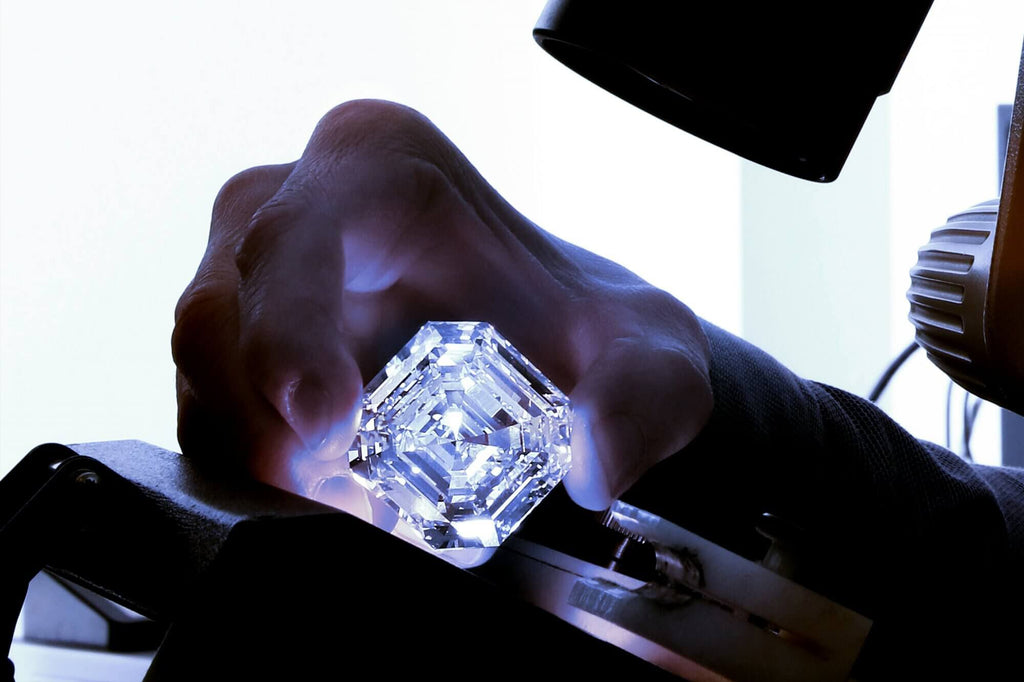You’ve heard of the 4Cs of diamond quality: color, clarity, cut and carat weight. But if you’ve been shopping for lab grown diamonds recently, you might have heard that they are Type IIa. What is diamond type and why should you pay attention to it? Don’t worry, we’ve got all the details.
What are Diamond Types?
Diamonds are pure crystalized carbon, the only gem that’s formed of a single element. They are remarkable pure because the strong bonds of carbon don’t make it easy for other elements to intrude. In fact, the carbon atoms in diamonds are so close together that you’d have to travel to a neutron star to find atoms closer together. The crystal structure of diamonds gives this gem its exceptional hardness, transparency, brilliance and fire. Diamond slows down light to half speed, making dance with light like no other gem on Earth.
Some diamonds do contain traces of other elements that were captured during formation. They give different diamonds slightly different physical properties and spectra that gemologists have organized into four basic categories, or types.
By far the most common diamond type is Type Ia. Type Ia diamonds contain nitrogen atoms in clusters in the carbon crystals. More than 97% of all natural diamonds are Type Ia. The nitrogen gives these diamonds a slight yellowish hue, ranging from almost colorless to light yellow. People also call this diamond type Cape diamonds after the huge discovery of diamonds in the Cape of South Africa in 1867. The Eureka Diamond, the first diamond discovered in South Africa, is a classic Type Ia.
Type Ib diamonds also contain nitrogen but as single nitrogen atoms rather than as clusters. Type Ib diamonds are usually bright yellow in color. Compared to Type Ia diamonds, Type Ib diamonds are really rare. People also call this diamond type Canary diamonds, after the bright yellow bird.
Type IIa diamonds, also referred to as Type 2a diamonds, have no measurable impurities. They don’t contain nitrogen or boron, which other diamond types do. They are usually colorless but they can sometimes be gray, light brown, light yellow or light pink thanks to missing carbon atoms in their crystal structure. Type II diamonds are the most pure diamonds. Less than 2% of natural diamonds are Type IIa. People also call this diamond type Golconda diamonds after a famous mine in India produced very pure diamonds in the 16th and 17th centuries.
Type IIb diamonds contain traces of boron. Interestingly, the boron sometimes makes Type IIb diamonds conduct electricity. Type IIb diamonds are often blue or grayish blue in color.

Why is Diamond Type Important?
Because most natural diamonds are Type Ia, most people who weren’t conducting diamond research didn’t pay much attention to diamond type. That changed when crystal growers learned to create diamonds in the laboratory. That’s because lab-grown diamonds are Type IIa, the purest diamond type.
Overnight, that made testing for diamond type a really important skill. If a diamond is not Type IIa, it’s not a lab grown diamond. Researchers created sophisticated diamond testing instruments that test to separate Type 2a diamonds from the other types. These machines are about $5000. Diamond dealers and jewelers use these machines to screen their inventory to make sure that there are no lab grown diamonds mixed in with their natural diamonds.
Of course, these testing machines don’t actually tell you whether of not a diamond is lab grown, since natural Type IIa diamonds do exist. But they do pass all the natural diamonds and flag all the Type IIa diamonds for further testing. Jewelers can send all the Type 2a diamonds to a gem laboratory for more advanced tests. At the lab, researchers use the absorption spectrum, growth zones and fluorescence under longwave and shortwave ultraviolet light to separate natural Type IIa diamonds from lab-grown Type IIa diamonds.
Famous Type IIa Diamonds
Of course the other reason why people care about Type IIa diamonds is that this diamond type includes some of the most beautiful diamonds of all. Sometimes Type 2a diamonds can be more colorless than other D color diamonds. Their exceptional purity means that light passes through more easily than other diamonds. People call this quality “diamonds of the first water.”

The world’s most famous diamond is Type IIa: the Cullinan. The largest gem-quality diamond ever, the 3,106-carat Cullinan rough diamond was mined in South Africa in 1905. The Transvaal colony government purchased the gem and presented it to King Edward of Britain. The largest gem cut from the Cullinan is the 530.40-carat Cullinan I, the Great Star of Africa, the largest gem quality polished diamond, which is mounted in the British Crown Jewels Sovereign Sceptre with Cross. The 317.40-carat Cullinan II is mounted int the British Imperial State Crown.
The 1,111-carat rough Lesedi La Rona diamond was discovered at the Karowe mine in Botswana in 2015. It was purchased for $53 million by Graff and cut into a 302.37 emerald cut. The pear-shape 203.04-carat Millennium Star diamond, the centerpiece of the De Beers Millennium diamond collection, was cut from a 777-carat rough diamond discovered in Zaire in 1990.
Other famous Type IIa diamonds include the Koh-i-Noor in the British Crown Jewels and the 182-carat light pink Daria-i-Noor diamond in the Iranian Crown Jewels. One exceptionally beautiful Type IIa diamond is the 33.19 carat Elizabeth Taylor Diamond, which the star wore as a ring. Her estate sold the ring for $8.8 million in 2011.

You may have noticed that many of the world’s largest diamonds are Type IIa. According to researchers at the Gemological Institute of America, most Type IIa natural diamonds are “super deep” diamonds that formed in the deepest part of Earth’s mantle between 360 and 750 km. (Most diamonds form between 150 and 230 km in the Earth's crust.) The conditions at that depth may have enabled very large very pure diamonds to form. The largest natural Type 2a diamonds are much larger than any yet grown in the laboratory.


